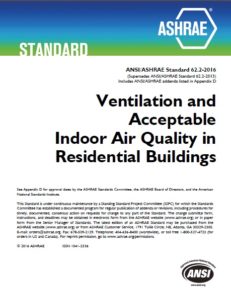ANSI/ASHRAE Standard 62.2-2016 Edition
ANSI/ASHRAE Standard 62.2-2016 Edition
ANSI/ASHRAE Standard 62.2-2016 Edition Ventilation and Acceptable Indoor Air Quality in Residential Buildings makes two major changes to scope by including unvented space heaters as a potential contaminant source and by expanding “covered dwellings” to include all multifamily dwelling units. A number of other significant changes also incorporated. A minimal calculated mechanical ventilation rate is provided for existing buildings, below which installation of whole-house ventilation is not required; a distinction is now made between range hoods and other kitchen ventilation options; new methods are provided for determining an infiltration credit for horizontally attached multifamily dwelling units and for determining requirements for a variety of noncontinuous ventilation strategies; and Also a maximum short-term relative exposure limit implemented for the first time.
Standard 62.2 defines the roles of and minimum requirements for mechanical and natural ventilation systems and the building envelope intended to provide acceptable indoor air quality in low-rise residential buildings. As in the previous editions of this standard, there are three primary sets of requirements and a number of secondary ones. The three primary sets involve whole-building ventilation, local demand-controlled exhaust, and source control. The secondary requirements focus on properties of specific items needed to achieve the main objectives of the standard. Standard 62.2 applies to spaces intended for human occupancy within single-family houses and multifamily structures, including manufactured and modular houses. This standard does not apply to transient housing such as hotels, motels, nursing homes, dormitories, or jails.
You can also Read ANSI/ASHRAE Standard 32.1 -201 7
ANSI/ASHRAE Standard 62.2-2016 Edition Ventilation and Acceptable Indoor Air Quality in Residential Buildings Content
- Purpose
![ASHRAE Standard 62.2-2016 Standard 62.2,ASHRAE Standard,ASHRAE,HVAC,Indoor Air Quality]()
- Scope
- Definitions
- Dwelling-Unit Ventilation
- Local Exhaust
- Other Requirements
- Air-Moving Equipment
- Climate Data References
- A—Existing Buildings
- Normative Appendix B—Infiltration Effectiveness Weather and Shielding Factors
- Normative Appendix C—Relative Exposure
- Informative Appendix D—Addenda Description Information
The standard considers chemical, physical, and biological contaminants that can affect air quality. It does not address thermal comfort requirements, specific pollutant concentration levels, or certain potential pollutant sources such as unvented combustion space heaters and contamination from outdoor sources or from episodic occupant-controlled events such as painting, smoking, cleaning, or other high-polluting events.


Comments are closed.